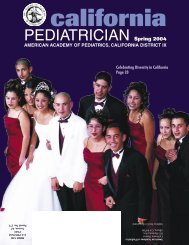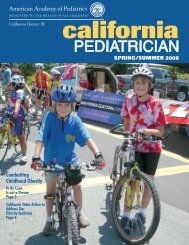PEDIATRICIAN Spring 2003 - AAP-CA
PEDIATRICIAN Spring 2003 - AAP-CA
PEDIATRICIAN Spring 2003 - AAP-CA
Create successful ePaper yourself
Turn your PDF publications into a flip-book with our unique Google optimized e-Paper software.
Preventing Ear Infections in Children<br />
Harry Pellman, M.D.<br />
Acute Otitis Media (AOM) is the<br />
most common bacterial infection<br />
diagnosed in children and the most<br />
common reason antibiotics are prescribed in<br />
this age group. Despite these facts, there is still<br />
quite a bit of controversy on how to best make<br />
the diagnosis of AOM and a good strategy for<br />
treating these infections. The American Academy<br />
of Pediatrics is intently working on new<br />
guidelines for the diagnosis and treatment of<br />
acute otitis media (AOM) in children.<br />
There are a variety of strategies known to<br />
reduce the frequency of middle ear problems.<br />
Implementing as many of these strategies as<br />
possible may be like closing the barn door<br />
before the cows get out.<br />
Breast feeding has been clearly shown to<br />
reduce both the incidence of AOM and<br />
otitis media with effusion (OME) in<br />
multiple studies. The protective effect is<br />
related to the duration and exclusivity of<br />
breast feeding and is most prevalent in<br />
infancy.<br />
Avoid environmental tobacco poisoning<br />
(aka cigarette smoking). This type of air<br />
pollution is clearly related to more AOM<br />
and OME.<br />
When bottle feeding, use fully vented bottles.<br />
Fully vented bottles allow air inflow<br />
as the milk exits the bottle and prevents<br />
negative middle ear pressure. Negative<br />
pressure in the middle ear promotes the<br />
entrance of nasopharyngeal contents into<br />
the middle ear chamber. Children using<br />
fully vented bottles have middle ear pressures<br />
that appear to be similar to infants<br />
breast feeding.<br />
Use of pacifiers beyond 18-24 months of age<br />
has been associated with more middle ear<br />
disease. The reason for this association is<br />
not clear. Whether this occurs because<br />
of abnormal pressures generated in the<br />
middle ear, more viral infections associated<br />
with pacifier use, or another mechanism<br />
is unknown.<br />
There are a variety of strategies known to reduce the frequency<br />
of middle ear problems. Implementing as many of these<br />
strategies as possible may be like closing the barn door before<br />
the cows get out.<br />
There is a suggestion that babies that have gastroesophageal<br />
reflux disease (GERD)<br />
have a higher incidence of middle ear<br />
disease. In one study, middle ear fluid<br />
obtained from children having myringotomy<br />
and tube insertion revealed pepsin<br />
and pepsinogen levels 1000 times higher<br />
than serum levels in more than 80% of<br />
children. Ongoing investigations will help<br />
clarify this issue.<br />
Daycare is associated with both an increased<br />
incidence of middle ear disease and the<br />
presence of more resistant bacteria when<br />
infections occur. Of course, daycare<br />
is essential for many working parents.<br />
Training daycare workers to wash hands<br />
frequently and employ hygienic measures<br />
is a Herculean task.<br />
Vaccines will have a dramatic impact on<br />
AOM. Prevnar vaccine provides significant<br />
protection against the seven strains of<br />
streptococcus pneumonia (in the past, the<br />
most common bacteria isolated in AOM)<br />
in the vaccine plus five cross-reacting<br />
strains. The vaccine has only reduced the<br />
overall incidence of AOM about 5-10%.<br />
However, the serotypes of streptococcus<br />
pneumonia present in the vaccine are both<br />
some of the most common bacteria present<br />
in AOM and the most resistant and<br />
difficult to treat bacteria we encounter.<br />
This vaccine has reduced the necessity<br />
for ear tubes about 20%, the frequency<br />
of having multiple episodes of AOM in<br />
an infection-prone child up to 20%, and<br />
changed the bacteriology of AOM so that<br />
non-typable hemophilus influenza bacteria<br />
is now the most common bacteria isolated<br />
in AOM in children vaccinated with<br />
prevnar. Work is presently being done<br />
on a nine-valent pneumococcal vaccine<br />
and a non-typable hemophilus influenza<br />
vaccine. Their impact on reducing AOM<br />
remains to be seen.<br />
Since most episodes of AOM follow viral<br />
respiratory illnesses, it appears that<br />
reducing these illnesses will lessen the<br />
frequency of AOM. Influenza vaccine,<br />
especially the newly released coldadapted<br />
live influenza vaccine, has been<br />
shown to effectively lessen the incidence<br />
of AOM. If a safe, effective RSV vaccine<br />
is ever approved by the FDA, we should<br />
expect a further reduction in AOM episodes.<br />
Xylitol is a natural, non-absorbable sugar most<br />
commonly harvested from birch trees.<br />
Xylitol chewing gum has been used in<br />
Finland for many years to reduce the<br />
incidence of dental caries, an infectious<br />
disease caused by strep mutans. Children<br />
on long term xylitol chewing gum were<br />
found to have as much as 40% fewer<br />
episodes of AOM. However, if used only<br />
during a high risk period, such as a viral<br />
respiratory infection, xylitol may not be<br />
protective. The usefulness of xylitol in<br />
other forms (syrup, lozenges, etc.) is still<br />
being investigated.<br />
There is a suggestion that iron deficiency<br />
anemia may be associated with an<br />
increased risk of AOM.<br />
It sounds like the ideal situation for maximum<br />
middle ear health is an infant exclusively<br />
breast fed for at least six months, living in a<br />
healthful environment without daycare, no<br />
pacifiers, bottles (if used) should be fully<br />
vented, kept on an iron rich diet, fully vaccinated,<br />
properly positioned to lessen GERD,<br />
and chewing xylitol chewing gum when old<br />
enough to do so.<br />
If employing the above strategies fails to<br />
reduce the incidence of ear infections, since<br />
frequent AOM seems to have some kind of<br />
genetic link, the child should consider choosing<br />
different parents!<br />
<strong>CA</strong>LIFORNIA <strong>PEDIATRICIAN</strong> — SPRING <strong>2003</strong>/ 9








